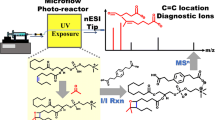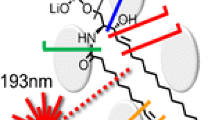Abstract
A “shotgun” tandem mass spectrometry (MS) approach involving the use of multiple lipid-class-specific precursor ion and neutral loss scan mode experiments has been employed to identify and characterize the glycerophosphatidylethanolamine (GPEtn) lipids that were present within a crude lipid extract of a normal rat retina, obtained with minimal sample handling prior to analysis. Characterization of these lipids was performed by complementary analysis of their protonated and deprotonated precursor ions, as well as their various ionic adducts (e.g., Na+, Cl-), using a triple-quadrupole mass spectrometer. Notably, the application of novel precursor ion and neutral loss scans of m/z 164 and m/z 43, respectively, for the specific identification of sodiated GPEtn precursor ions following the addition of 500 μM NaCl to the crude lipid extracts was demonstrated. The use of these novel MS/MS scans in parallel provided simplified MS/MS spectra and enhanced the detection of 1-alkenyl, 2-acyl (plasmenyl) GPEtn lipids relative to the positive ion mode neutral loss m/z 141 commonly used for GPEtn analysis. Furthermore, the novel use of a “low energy” neutral loss scan mode experiment to monitor for the exclusive loss of 36m/z (HCl) from [M+Cl]- GPEtn adducts was demonstrated to provide a more than 25-fold enhancement for the detection of GPEtn lipids in negative ion mode analysis. Subsequent “high-energy” pseudo MS3 product ion scans on the precursor ions identified from this experiment were then employed to rapidly characterize the fatty acyl chain substituents of the GPEtn lipids.






Similar content being viewed by others
References
LaBaer J (2005) J Proteome Res 4:1053–1059
Semmes OJ, Malik G, Ward M (2006) J Cell Biochem 98:496–503
Wenk MR (2005) Nat Rev Drug Discov 4:594–610
Jones JJ, Borgmann S, Wilkins CL et al (2006) Anal Chem 78:3062–3071
Estrada R, Yappert MC (2004) J Mass Spectrom 39:412–422
Jones JJ, Batoy SM, Wilkins CL (2005) Comput Biol Chem 29:294–302
Brugger B, Erben G, Sandhoff R et al (1997) Proc Natl Acad Sci USA 94:2339–2344
Ejsing CS, Duchoslav E, Sampaio J et al (2006) Anal Chem 78:6202–6214
Ekroos K, Chernushevich IV, Simons K et al (2002) Anal Chem 74:941–949
Han X, Gross RW (2003) J Lipid Res 44:1071–1079
Pulfer M, Murphy RC (2003) Mass Spectrom Rev 22:332–364
Han X, Gross RW (2005) Mass Spectrom Rev 24:367–412
Schwudke D, Hannich JT, Surendranath V et al (2007) Anal Chem 79:4083–4093
Schwudke D, Oegema J, Burton L et al (2006) Anal Chem 78:585–595
Ejsing C (2007) Doctoral dissertation, Technische Universitat Dresden, Dresden
Zhang X, Reid GE (2006) Int J Mass Spectrom 252:242–255
Folch J, Lees M, Sloane Stanley GH (1957) J Biol Chem 226:497–509
Haimi P, Uphoff A, Hermansson M et al (2006) Anal Chem 78:8324–8331
Han X, Gross R (1995) J Am Soc Mass Spectrom 6:1202–1210
Murphy R (2002) Mass spectrometry of phospholipids: tables of molecular and product ions. Illuminati, Denver
Simões C, Simões V, Reis A et al (2008) Rapid Commun Mass Spectrom 22:3238–3244
Zemski Berry K, Murphy R (2004) J Am Soc Mass Spectrom 15:1499–1508
Murphy EJ, Stephens R, Jurkowitz-Alexander M et al (1993) Lipids 28:565–568
Hsu F, Turk J (2000) J Mass Spectrom 35:596–606
Harrison K, Murphy R (1995) J Mass Spectrom 30:1772–1773
Fahy E, Subramaniam S, Brown HA et al (2005) J Lipid Res 46:839–861
Author information
Authors and Affiliations
Corresponding author
Electronic supplementary material
Below is the link to the electronic supplementary material.
Supplementary Table 1
Summary of glycerophosphatidylethanolamine (GPEtn) lipids identified from a whole rat retina crude lipid extract by complementary neutral loss and precursor ion scan mode tandem mass spectrometry. Fatty acyl species were determined by negative ion mode product ion CID-MS/MS or by PI scans of m/z of specific fatty acids. Lipid nomenclature used is outlined in [26] (DOC 41 kb)
Rights and permissions
About this article
Cite this article
Lydic, T.A., Busik, J.V., Esselman, W.J. et al. Complementary precursor ion and neutral loss scan mode tandem mass spectrometry for the analysis of glycerophosphatidylethanolamine lipids from whole rat retina. Anal Bioanal Chem 394, 267–275 (2009). https://doi.org/10.1007/s00216-009-2717-9
Received:
Revised:
Accepted:
Published:
Issue Date:
DOI: https://doi.org/10.1007/s00216-009-2717-9




